Attention psychology example (Part-3)
This article is on Divided Attention. Attention Psychology Example (Part-3) We will talk about approaches to divided attention suggesting, whether we have a single pool of attention sources or multiple sources of attention, and how it is allotted. The latter part of the article covers the factors that influence our ability to pay attention and it closes with the neuroscience of attention.
Divided Attention
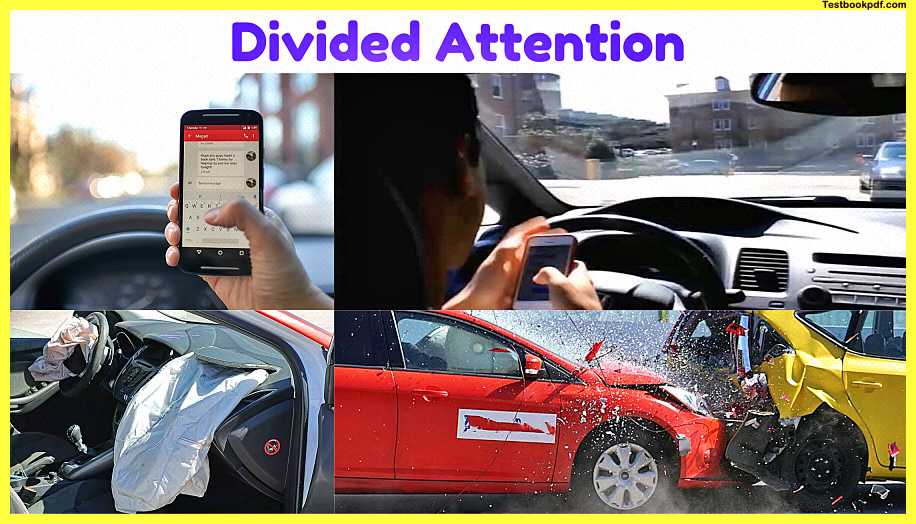
We have been talking about attention in the last couple of articles, in the first article, we talked about the visual search we talked about how you use attention to search for particular objects in your environment say for example whether you follow a process of features looking for specific features whether you follow a process of looking for a combination of features and then we talked about how do you do this selection we talked about selective attention today we will talk about what is called divided attention.
Now it is no surprise and it might not come as a novelty to any of you for that matter that we do for the most part do two things at once say for example this gentleman right here in this figure is actually driving and trying to text at the same time and this is actually where you start misusing your capacities of dividing nation ok in this particular course we will try and see how good or a bad decision something like this, we will talk about the fact that we can handle more than one information more than one kind of stimulus more than one kind of location at the same time yes we can do that we will also though talk about the limitations of being able to do that how do we do that what are the processes involved in doing that and how does our attention facilitate or sometimes acts as a limitation in doing two things at the same time this one, however, is a bad example to follow.
So we let us move towards investigating what divided attention does in a safer scenario of a particular lab now one of the early works done in the area of divided attention had participants view a videotape in which they saw the display of a basketball game superimposed on the display of a hand slapping game so they were these individuals they were actually they were brought in front of a screen maybe it was presented to them and they were actually looking at two activities at the same time they were looking at a basketball game and also at the same time looking at the display of a hand slapping game.
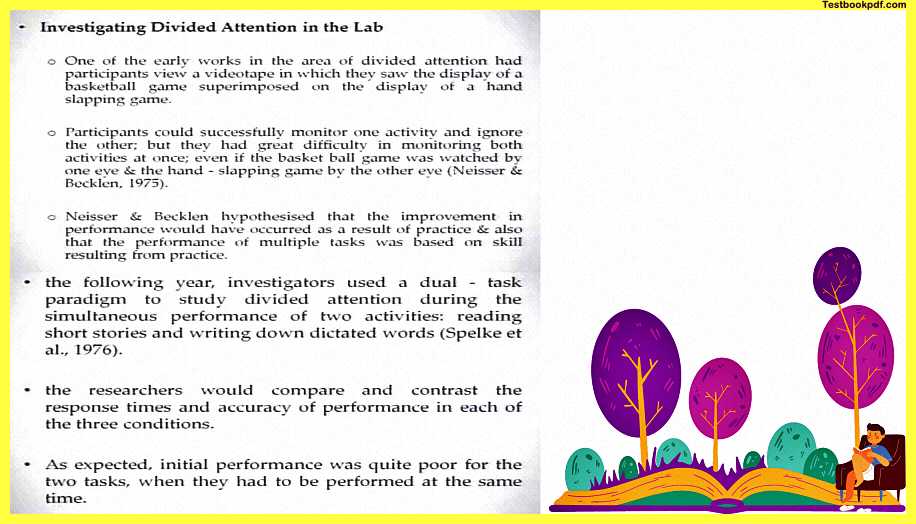
Now, these participants could successfully monitor one activity and ignore the others if they were told that you just focus on viewing the basketball game or say for example if they were advised to just focus on the hand slapping game they could do that very successfully but in a third condition if they were asked to follow both the games simultaneously and do some kind of reporting about what happened and something like that they had great difficulty in monitoring both these activities at the same time even if the basketball game was washed by one eye and the hand slapping game by the other I say one you can do say for example I will just divide one of my eyes to doing this on the ISO doing this I’m not really sure how possible that is but even if people would use a strategy as interesting as that they were not really successful in doing that.
Now Neisser and Becklin who did this study hypothesized that the improvement in performance could have happened if the partisans would have practiced enough now as a result of practice they would have acquired the skill of monitoring each of these games first and then each of these games simultaneously.
Now, this is where your ability of divided attention comes in the attention we have seen that is the ability to select information and work at one information and one time and the other information later but this is a different kind of thing when you are saying that you can attend to more than one thing more than one event or object or location at the same time so this is what is called divided attention now in the following year the same investigators they used a dual-task paradigm to study divided attention during the simultaneous performance.
so, earlier was observed this is a performance task and the two activities these participants were performing were reading short stories and writing down dictated words so in one activity they are actually reading a short story, and they with the second thing they are being dictated some words and they have to write that down so two activities are happening here.
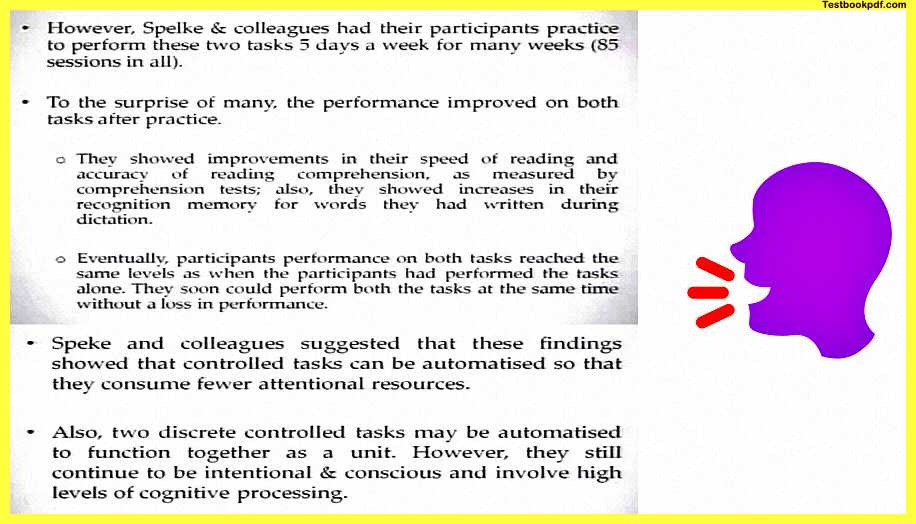
Now the researchers actually would compare and contrast the response times and accuracy in each of the three conditions what will be three conditions the first condition will be doing the reading task the second condition will be doing the dictation task and the third and the most important condition for our purposes is a condition wherein they are doing both of these tasks simultaneously now as expected the initial performance was quite poor across the two tasks when they had to be performed at the same time but Speke and colleagues they had their participants practice to perform these two tasks five days a week for around 17 weeks total of 85 sessions in all so they kind of spends a lot of time practicing these two skills reading a story taking dictation at the same time now to the surprise of many the performance actually improved on both the tasks after practice.
So the participants were showing improvement in their speed of reading and their accuracy of reading comprehension as measured by the compression tests on whatever passages they were presented with also they showed increases in their recognition memory forwards they had written during the dictation part so they are kind of not only getting better at each of these tasks independently they are getting better at performing these tasks together so eventually these participants performance on both the tasks also reached the same levels as when they would perform each of these tasks alone so that is quite an improvement in itself.
Now they could perform both of these tasks at the same time without any loss in performance on both say for example if you would say that I have this hundred percent capacity of doing a particular task if I am doing two tasks then I probably divide it 50-50 this case the participants are doing both the task at hundred percent at the same time now spec and colleagues who were doing this research of examining these two dual tasks they suggested that these findings are showing that control tasks can also be automatized.
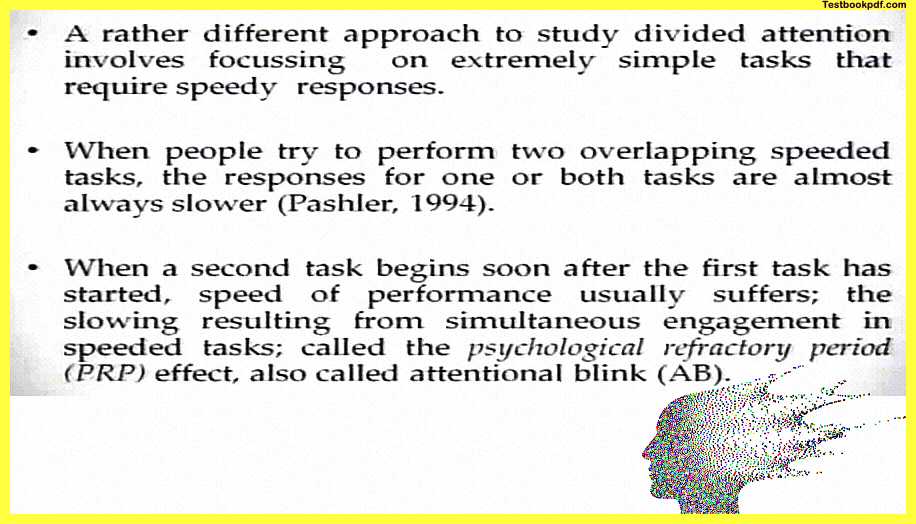
So that they consume fewer attentional resources also two discrete control tasks may be optimized as a function together as a unit if you are doing two tasks together say and you have practiced them in your if you are good at them enough you can synthesize them some people study by repeating whatever they are reading so they are speaking and reading at the same time and they to them both of them are working as a one unit task and is working pretty well so however they still continue to be intentional and conscious and involve high levels of cognitive processing its not really taking away all their resources because they are doing two tasks they have evolved or practiced their skills as much that they both of these tasks are functioning together and they function as one unit of a task.
Now a slightly different approach to studying divided attention could be involving focusing on very simple task very very very simple tasks that require speedy responses an example could be said for example if people try to perform overlapping speeded recognition tasks like the one we do in our labs the response for one or both tasks are always slower so for example if you if the second task begins soon after the first task started the speed of the performance usually starts to suffer the slowing is actually resulting from simultaneous engagement in these two speeded tasks this slowing is called the psychological refractory period also has been referred to as the attentional blink phenomena in attention research.
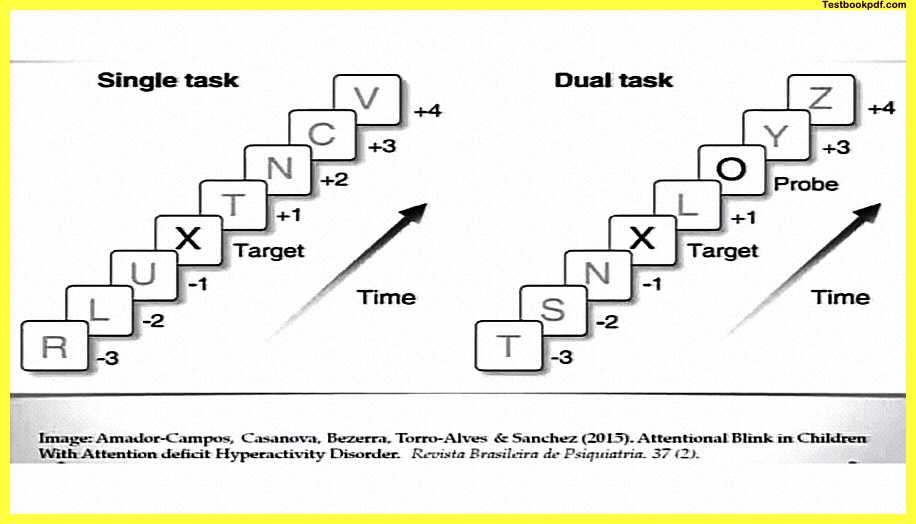
Now herein is a good example in a single task scenario I can just ask you to spot a black x among these rapid serial visual presentations of grey alphabets so these grey alphabets will be presented one after another in quick succession generally with the presentation type of around 75 or 50 milliseconds and then the task of the participant is to just recognize whether in that particular rsvp sequence black x were presented or not so this is one kind of performance participants generally do very well at it.
Now I can make this slightly twisted and I can tell you that okay you have to Perfor spot a black x but you also have to spot a black o after that x that might appear not appear might be closer to the x layer further from the x all of those things I would be able to manipulate but I am giving you two tasks here I am giving you to identify two targets t1 and t2 again in the same rsvp stream it has been found in research has shown that the performance in identifying the second target generally suffers.
PRP Effect
Now findings from these PRP studies these kinds of studies indicate that people can accommodate fairly easy perceptual processing of physical properties or sensory stability when engaged in a second speeded task so they can with practice do that as well however they cannot readily accomplish more than one cognitive task requiring them to choose a response rate to or retrieve information from memory or engage in various other cognitive operations at the same time so one or both the task will generally show the PRP effect it will show the characteristics slowing down it will it might show the characteristic fall in accuracy as well.
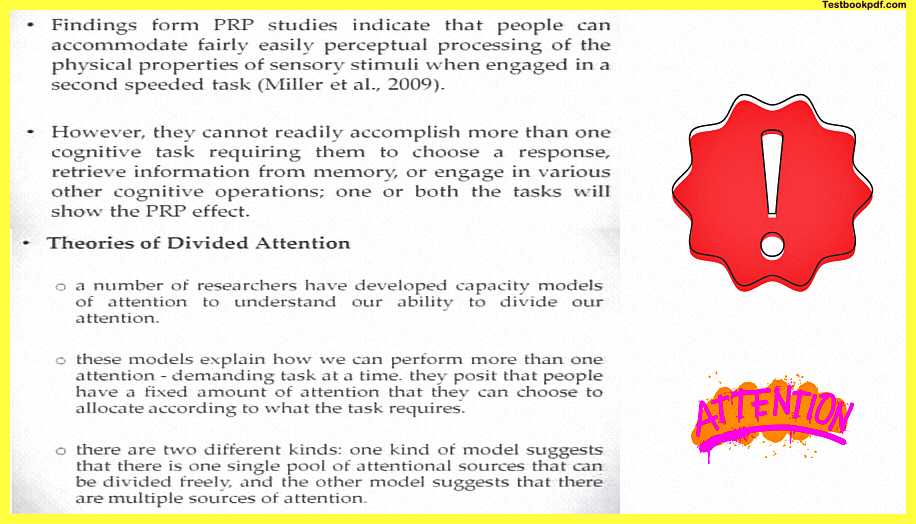
What kind of theories does talk about divided attention?
Now a number of researchers have developed capacity models of attention to understand our ability to divide our attention so the whole point of being able to divide attention is that you have a limited attentional capacity and you kind of divide this into two tasks which you are doing or which you intend to do at the same time now these kinds of capacity models explain how we can perform more than one attention-demanding task at the same time these posit people have a fixed amount of attention that they can choose to allocate according to whatever task requirements if you are doing an easier task and a difficult task it might be slightly easier to do it if you are doing two equally highly demanding terms then it might be slightly difficult to allocate attention and manage that.

Now there are two different kinds of models that have been proposed one kind of model suggests that there is only one single pool of attentional resources so all that sensory information that you need to negotiate with there is only one pool of attentional resources that you would have and resources can be divided according to the needs of the two tasks at hand the other model suggests that there are multiple sources of attention and there might not be a problem in Nego in negotiating the two tasks or three tasks at the same time because you can say for example ask different pools of attention to be allocated to different tasks at the same time now these are the two kinds of models here you will see a graphic of that borrowed from Sternberg and Sternberg their textbook on cognitive psychology.
Single resource model of attention
Now in the panel you can see that there is one single attentional pool whatever stimuli input are coming in part of that intentional pool is allocated to task one part of that is allocated to task two and then you select whatever activities you have to do maybe press a key given verbal response whatever you want to do this is called the single resource model of attention or something like that the second model if you see which is the panel b you can find that whatever stimulus inputs are coming in they are actually entering in via two different modalities.
So, there is modality one and there is modality two and what you are basically doing is there are separate mental resources allocated to modality one and modality two and so your selection of possible activities that you have to do directly follows from these two different modalities and in that sense there will be less conflict and actual responses could be had later.
Now, these are the two metaphors these are the two hypothetical assumptions see these are not really hard facts that attention really operates in this manner these are two hypothetical approaches to study attention, and both of these kinds of theories have been tested there have been a lot of experiments and those experiments have said a few things we will.
Now talk about now even if you look back at these models and say for example if you are wondering that obviously, these models do represent a degree of over-simplification these models are much better and it has been found that people are much better at dividing attention when competing tasks are in different modalities say for example if one task is in the visual modality the other task in the auditory modality people have been able to do that people have been found to do that almost effortlessly without really slowing down or without really being too inaccurate.
So, it can be said that at least some attentional resources might be specific to a particular modality verbal or visual in which a task is presented say for example you might also have done it a lot of times that you will see most people can listen to music and concentrate on writing simultaneously a lot of people do listen to music and drive they cannot even in some sense drive if there is no music around in the car so people are doing two things at the same time in a lot of instances and so that this whole concept of different modalities having different kinds of attention resources still do start making some sense.
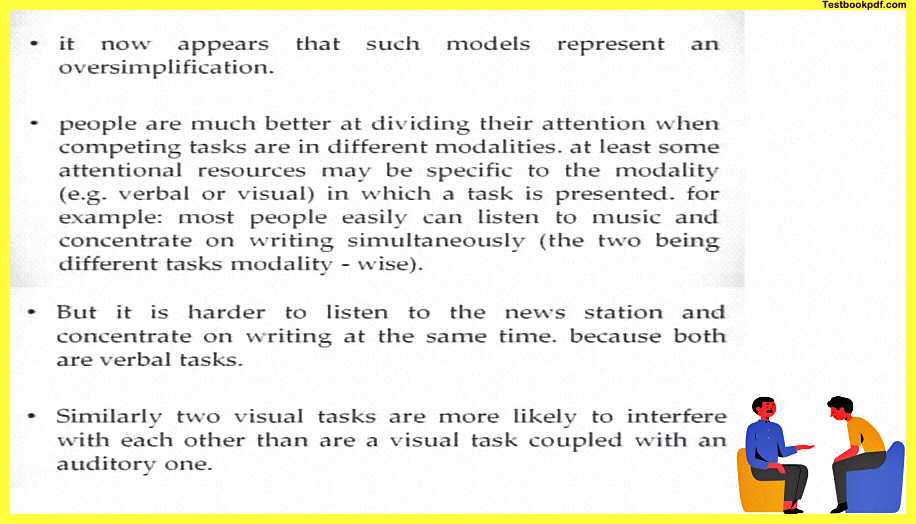
Now it is though harder to listen to the news station and concentrate try on writing about this at the same time because the information coming from a particular news station is also new might be relevant to you you might get interested in that so you’re kind of allocating a sizable amount of resources to that also writing needs the sizable amount of resources and in then it gets difficult another thing is that they are both verbal tasks they are both tasks about language.
So in the language modality, it might be difficult then to divide the same kind of resource that the language modality has into two language tasks at the same time verbal tasks at the same time similarly if you give somebody two visual tasks they are also more likely to interfere with each other than are a visual task compared with the auditory task or an auditory task compared with the haptic tasks something like that.
So within modalities certainly there is this notion of capacity limitation within modality you try and put in too many tasks always see the finding of the PRP thing that there will be that characteristic slowing down and there will be those extra errors that will start coming in attentional resource theory the ones which we’ve been talking about they have been criticized heavily as being slightly broad and vague resource theory than in that sense seems to be a slightly better metaphor for explaining the phenomena of divided attention on complex tasks in these tasks practice effects may also be observed when the person gets used to it when the person gets highly skilled and that in that particular task they do this become better.
Now according to this metaphor of the resource theory each of these complex tasks become increasingly automatized when you are getting good at driving and listening to music I can share one of these instances which happened to me when I started to learn driving I used to get really disturbed when somebody is playing a radio or when somebody is playing radio on a higher volume as and when I practiced over the course of a few months I got better at driving and in that sense.
Now I do obviously listen to music while I am driving so as the task becomes increasingly automatized as you scale on those particular tasks get better the performance of each task.
now going to make fewer demands on your retention resources and in that sense, both of these tasks at the same time will become more and more manageable that is pretty much what this concept of divided attention and this whole concept of resource theory tells you.
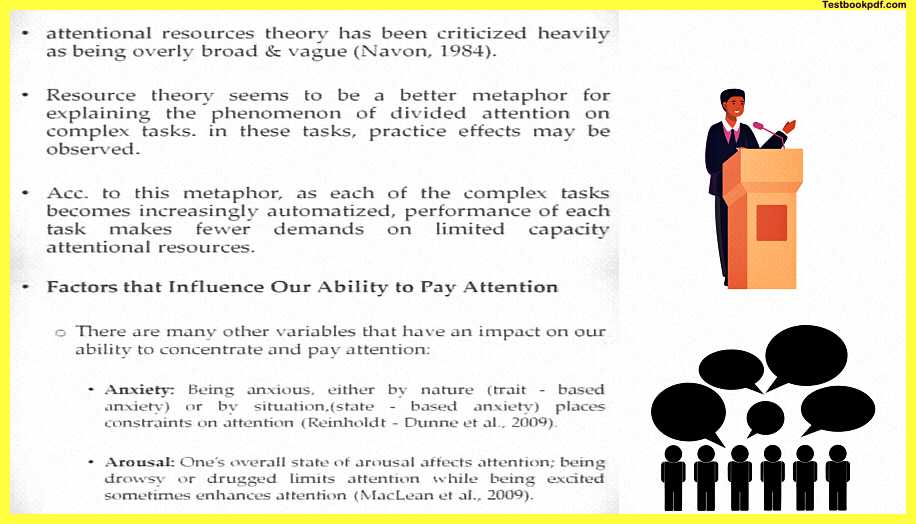
Factors: Ability to Pay Attention
Now let us talk a little bit about the factors that might influence our ability to pay attention to two or more things at the same time say for example if you are anxious anxiety is a very important factor if you are anxious either by nature some people are nervous by nature some people are slightly cautious by nature or say for example by the situation if there is say for example something really important going to happen an interview is there or some very difficult task is there or say for example you just had a very a bad fight with somebody but you still have to sit in a particular exam both kinds of anxiety do place constraints on the attention you will find that your ability to concentrate on even one thing for that matter but on two things certainly becomes very very difficult the second factor could be arousal so arousal is basically the concept of general activity and a general feeling of energy or lethargy in your body.
No one’s overall state of arousal obviously affects and it kind of imparts attention so if you’re drowsy or drug if you are very sleepy, say for example it is always said with drivers that they should be well rested if you are going for a long trip, especially at the time of the night so if you are very very drowsy or very lethargic then your attentional capacities will slightly be limited or say for example if you’re too excited to even if you kind of very very excited if you’re very happy and sometimes it happens with friends your attention capacities will slightly be better and your overall attention will be slightly better if it is drowsy it will be lower if it is your kind of optimally excited will be better if you are too excited however then also it might be a problem another important factor about how you can really govern your attention is that the task difficulty
Now task difficulty particularly influences people’s performance during divided if I’m giving you two easy tasks to perform you will do it very well if I am giving you one easy and one difficult task to perform you might still do okay but if I’m giving you two difficult tasks to be done at the same time under time pressure you will certainly find it very very difficult to do it another aspect as we saw with the experiment of spk and colleagues is that your skills play a very important role the more practiced and the more skilled you become in performing each of the tasks at hand the better you will be in performing two tasks two of these tasks at the same time so your attention is enhanced your processing is enhanced and better if you are performing two tasks at the same time.
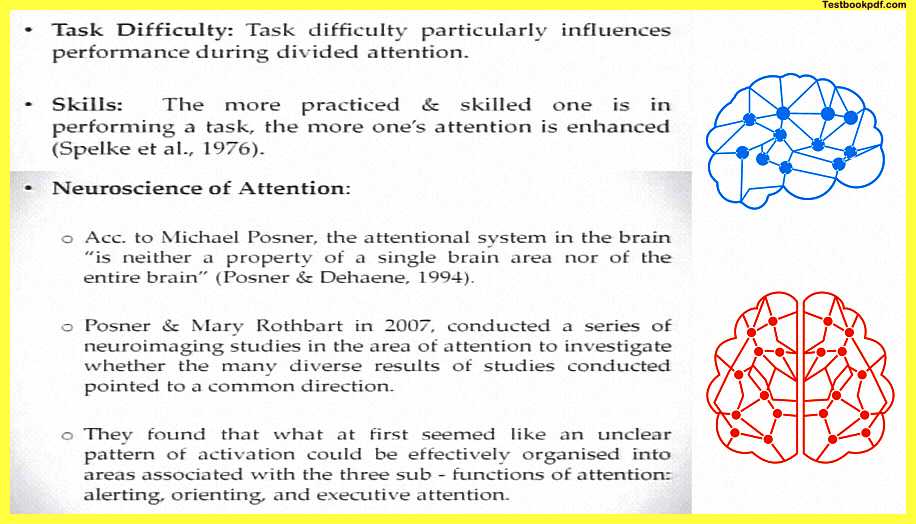
Now let us talk a little bit again about the brain and what it has to do with attention so there is this gentleman a very important gentleman in the theory of attention and attention research or in most of the cognitive psychology Michael Posner basically said that the attentional system is in the brain is neither a property of a single brain area and it is not the property of the entire brain as well Posner and mary wrote but in 2007 they conducted a series of neuroimaging studies in the area of attention to investigate whether the many diverse results of studies conducted points to a common direction.
So they actually conducted a series of neuroimaging studies fMRI studies that are in the area of attention and they wanted to investigate, Whether the many diverse results because there was a lot of research going on in attention in the past two or three decades and they actually wanted to try and integrate and combine all of the findings from all of these studies and to say whether there is a unique direction whether there are some commonalities in all of this literature that can be coming out.
So Posner and Rothbard found first that what at first seemed like an unclear pattern of results and findings could be effectively organized into areas associated with three sub-functions of it so they were actually looking at the brain they were actually looking at how the brain is negotiating attention and what are the areas of the brain they are responding to various aspects and various facets of attention so they found that what actually looked like an unclear activation over a distributed area of the brain can actually be effectively organized into three sub-functions of attention these sub-functions they said are alerting orienting and executive attention let us talk about all of these three things in more detail.
Alerting
Now alerting is basically that aspect of attention that is about being prepared to attend to some incoming event and maintaining this attention so alerting also includes the process of getting into the state of preparedness if you are simple on television there is a number going to be announced and that number is of a particular lottery and you are also having a lottery ticket in your hand you are prepared that.
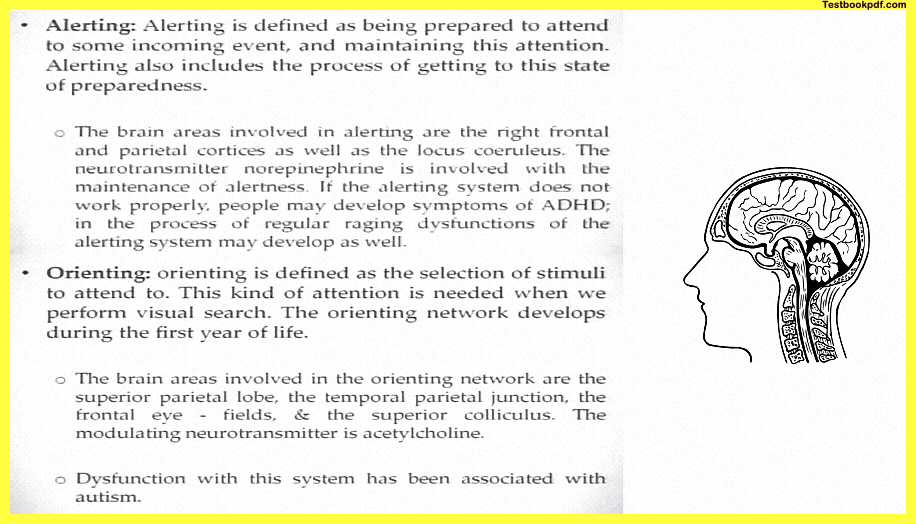
Now, this announcement will be coming up say for example if you sitting at airport lounges and waiting for the flight announcement or in a railway station waiting for your train announcement you are actually prepared and alert to the possibility of that announcement being made so that you do not miss out on any important information so that is basically what alerting is about.
Now, the brain areas that might be involved in alerting are the right frontal and parietal cortexes as well as what is called a locus Cornelius.
Orienting
Now the neurotransmitter non-epinephrine is also found to be involved with the maintenance of alertness also if the alerting system does not work properly people may develop symptoms of what is called attention deficit hyperactivity disorder we can talk about this in a later section but this in the this is the process of regular raging dysfunctions of learning systems and it kind of can make it very difficult for people to concentrate on specific things orienting is defined as the selection of stimuli to attend to if there are too many things going on.
If there are too many announcements being made and too many people talking around you you might want to orient your attention to select something very specific and then listen and analyze and process that this kind of attention is needed when you are performing say for example visual search kind of task your orienting network develops during the first year of you will see that children even very young children are also able to orient towards particular assembly if you clap if you kind of give some kind of body they can select to that stimuli and look at that and then maybe their attention fades off.
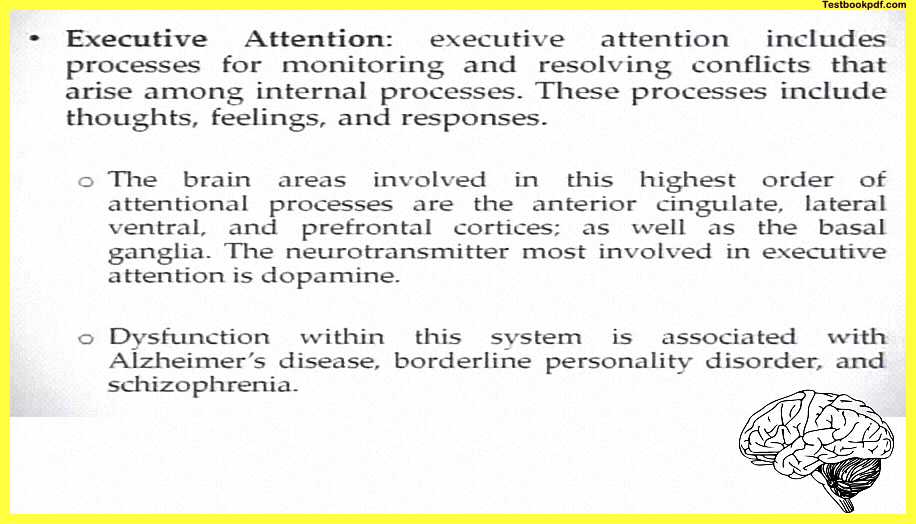 Attention-Psychology-Example
Attention-Psychology-Example
Now the brain areas involved in the orienting network are the superior parietal lobe the temporal parietal junction the frontal eye fields and the superior colliculus the modulating transform neurotransmitter that kind of modulates the activity of this network is acetylcholine.
Autism
Now dysfunction with this system has been associated with what is called autism. autism is a cognitive disorder which has to do a lot with that people afflicted with autism are not able to orient and attend to something or concentrate on things over periods of time again we can talk about autism in more detail at a later point the other thing is executive attention, executive attention includes the processes for monitoring and resolving conflicts that arise among internal say, for example, you are processing too many things at the same time too much information is coming you have to select to that I will select this I will select that I will if there is a conflict of response all of those kinds of things feelings.
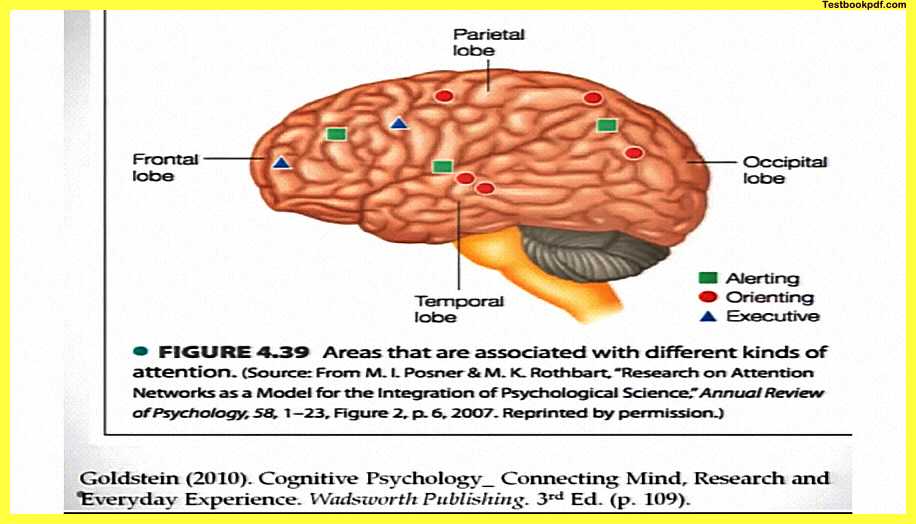
For example if there is somebody saying something you’re feeling very angry but you suppress your anger you still start continue talking peacefully those kind of social dilemmas are actually handled by this executive network the brain areas involved in the this highest order of attention processing are the anterior cingulate cortex lateral ventral and prefrontal cortex as well as the basal ganglia the neurotransmitter that is involved in executive functioning is dopamine.
Now dysfunction with this kind of system the executive attention system is associated with diseases like Alzheimer’s disease borderline personality disorder and schizophrenia.
Distractions while Driving
Now here is the figure of the brain again borrowed from Goldstein and his textbook of cognitive psychology you can see what are these different networks of attention and how are they organized or scattered across the brain we have to begin this chapter on divided attention by giving this example of distractions while driving.
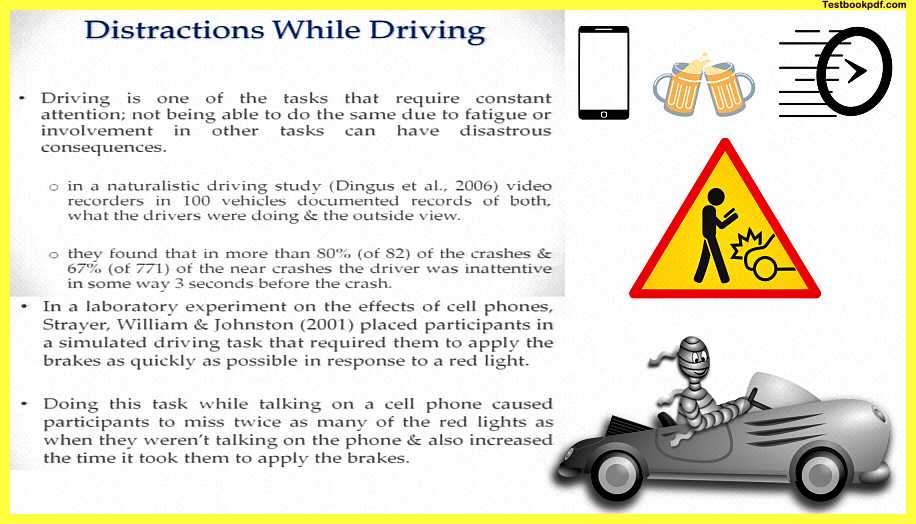
Now driving is one of the I’m just going to present a very important study to you so that it kind of impresses enough that doing something else while you’re driving is rather dangerous so driving is one of the tasks that actually require constant attention and not being able to do due the same due to fatigue or involvement in other tasks can have and does have disastrous consequences in a naturalistic observation study of driving in the video recorders were placed in 100 vehicles and they documented records of both what the drivers were doing and also the outside view and this was done by dingus and colleagues in 2006 they actually found out that in more than 80 percent of the crashes and 67 percent of the near crashes the driver was actually inattentive in some way three seconds prior to the crash so I mean it’s living proof its experimental proof of the fact that it’s very dangerous to do anything else while driving.
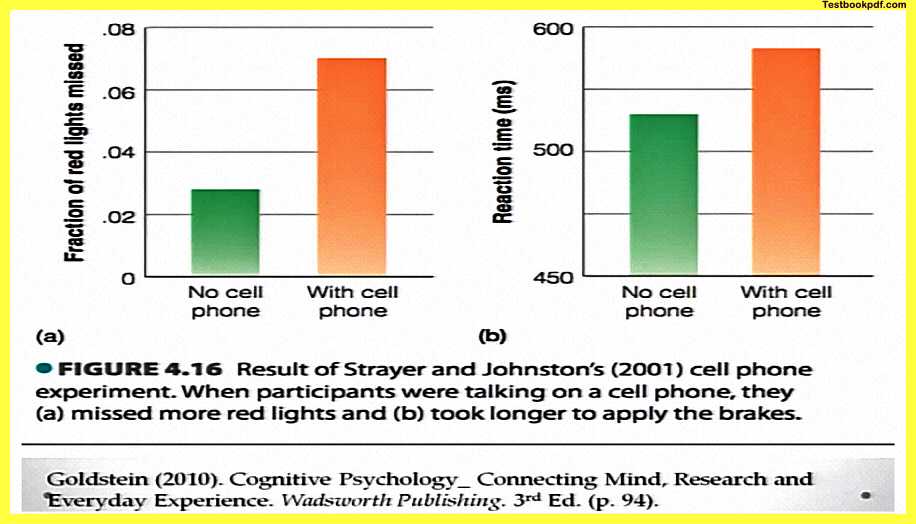
Now in a laboratory experiment on the effects of cell phone strayer and colleagues’ strayers, Williams and Johnston placed participants in a simulated driving task that required them to apply brakes as quickly as possible as soon as a red light flashed.
Now doing this task while talking on a cell phone caused participants to miss twice as many of the red lights as when they weren’t talking on the phone or they weren’t doing something else here are the results so if you can basically see the number of red lights miss is much higher than when they were doing with cell phones and say for example the reaction time is also much higher when they are driving along with cell phones so this is again experimental proof of why it is very dangerous to do anything while you’re driving strayer and Johnston concluded from this result that talking on the phone uses cognitive.
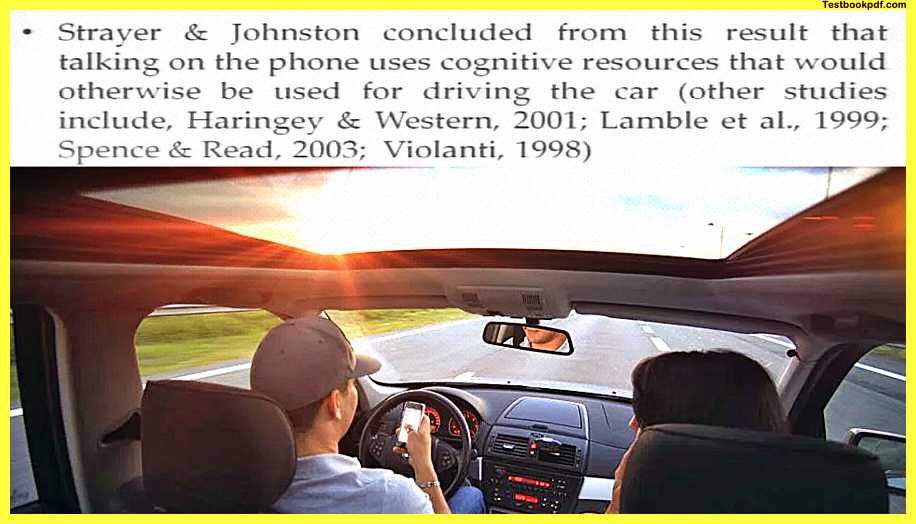
So obviously you’re listening to somebody you’re attending to the voice on the phone over all the other voices of traffic horns maybe somebody from the back is honking and wants a pass all of those you’re not selecting you’re selecting this voice on the phone and that would otherwise basically that will be the problem.
so it takes up cognitive resources that would have been actually being used while you were driving the car this is all I hope I have impressed enough about the good parts of divided attention and also while the end about what the unfortunate or misuse of divided attention would be thank you so much.
Read also:
Attention in Psychology Pdf (Part-1)
